
The long-tailed broadbill is a species of bird that is found in the Himalayas, extending east through Northeastern India to Southeast Asia. It is the only bird in the genus Psarisomus. The long-tailed broadbill is about 25 cm (10 inches) in length and weighs between 50 and 60 grams. It can be identified by its shrill call.
The flora and fauna of Chennai are the plants and animals in Chennai, India.

Dibru-Saikhowa National Park is a national park in Assam, India, located in Dibrugarh and Tinsukia districts. It was designated a Biosphere Reserve in July 1997 with an area of 765 km2 (295 sq mi), including a core area of 340 km2 (130 sq mi) and a buffer zone of 425 km2 (164 sq mi).

The black softshell turtle or Bostami turtle, previously placed in genus Aspideretes, is a species of freshwater turtle found in India (Assam) and Bangladesh. It was long believed to be inbred individuals of the Indian softshell turtle or the Indian peacock softshell turtle, but while it is a close relative of the latter, it is a distinct species. In the 1800s it was believed these turtles were brought from Iran to Chittagong shrine pond by Hazrat Bayezid Bostami. His turtles he had brought to this pond were treated as sacred and respected by the public. Previously declared extinct by the International Union for Conservation of Nature in 2002, these turtles were found still to exist in a temple's pond called the Hayagriva Madhava Temple located in Assam, India. Through conservation methods and protection of the species, some of these turtles can be found today throughout the wild, and scientists and environmental biologists are continuing to work hard to preserve this endangered species and their natural habitat.

The grey-headed parakeet is closely related to the slaty-headed parakeet which together form a super-species. It is found in Southeast Asia from north-eastern India to Vietnam.

Troides minos, the southern birdwing, is a large and striking swallowtail butterfly endemic to south India. With a wingspan of 140–190 mm, it is the second largest butterfly of India. It is listed as Least Concern in the IUCN Red List.
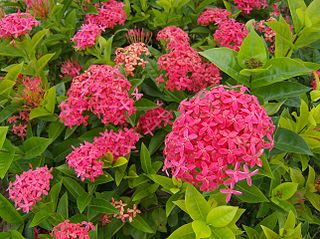
Ixora is a genus of flowering plants in the family Rubiaceae. It is the only genus in the tribe Ixoreae. It consists of tropical evergreen trees and shrubs and holds around 562 species. Though native to the tropical and subtropical areas throughout the world, its centre of diversity is in Tropical Asia. Ixora also grows commonly in subtropical climates in the United States, such as Florida where it is commonly known as West Indian jasmine. Other common names include viruchi, rangan, kheme, ponna, chann tanea, techi, pan, siantan, jarum-jarum/jejarum, jungle flame, jungle geranium, and cruz de Malta, among others. The plants possess leathery leaves, ranging from 3 to 6 inches in length, and produce large clusters of tiny flowers in the summer. Members of Ixora prefer acidic soil, and are suitable choices for bonsai. It is also a popular choice for hedges in parts of South East Asia. In tropical climates they flower year round and are commonly used in Hindu worship, as well as in ayurveda and Indian folk medicine.

The state of Karnataka in South India has a rich diversity of flora and fauna. It has a recorded forest area of 38720 km2 which constitutes 12.3467719% of the total geographical area of the state. These forests support 25% of the elephant population and 20% of the tiger population of India. Many regions of Karnataka are still unexplored and new species of flora and fauna are still found. The Western Ghats mountains in the western region of Karnataka are a biodiversity hotspot. Two sub-clusters of the Western Ghats, Talacauvery and Kudremukh in Karnataka, are in a tentative list of sites that could be designated as World Heritage Sites by UNESCO. The Bandipur and Nagarahole national parks which fall outside these subclusters were included in the Nilgiri biosphere reserve in 1986, a UNESCO designation. Biligiriranga Hills in Karnataka is a place where Eastern Ghats meets Western Ghats. The state bird and state animal of Karnataka are Indian roller and the Indian elephant respectively. The state tree and state flower are sandalwood and lotus respectively. Karnataka is home to 406+ tigers.
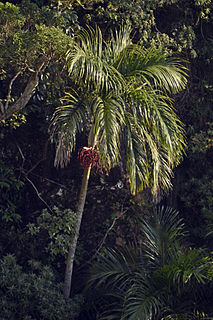
Bentinckia condapanna, the hill areca nut, is a species of flowering plant in the family Arecaceae. It is found only in India. It is threatened by habitat loss. This palm is mainly found in the evergreen forests of Western Ghats of India.

Aporosa bourdillonii is a species of plant in the family Phyllanthaceae. It is endemic to India. It prefers evergreen and semi-evergreen forests.

Rhododendron arboreum, the tree rhododendron, also known as Burans or Laligurans or simply Gurans in Nepal, is an evergreen shrub or small tree with a showy display of bright red flowers. It is found in Bhutan, China, India, Myanmar, Nepal, Sri Lanka, Pakistan and Thailand. Rhododendron arboreum is the national flower of Nepal; in India it is the state tree of Uttarakhand and state flower of Nagaland.

Artocarpus hirsutus, commonly known as wild jack, is a tropical evergreen tree species that is native to India, primarily in Kerala, but also in Karnataka, Maharashtra and Tamil Nadu, where it prefers moist, deciduous to partially evergreen woodlands.
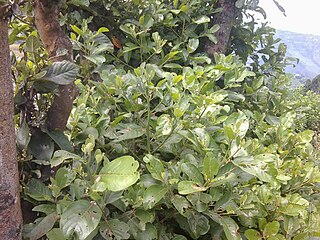
Litsea monopetala is a plant in the genus Litsea, found in the regions from the Terai to 1450 m, in Shorea robusta forest and tropical evergreen forest in Nepal. Outside Nepal, its range extends from Kumaon to Sikkim, Bangladesh, Burma and southwest China. In India it is found in Assam, Odisha, Eastern Himalayas, Maharashtra and Tamil Nadu (Coimbatore).
Rajbari National Park is a national park in the Trishna Wildlife Sanctuary, Tripura, India. It covers an area of about 31.63 square kilometres (12.21 sq mi).

Ardisia solanacea, called shoebutton ardisia in English, is a species of the genus Ardisia in family Primulaceae.

Alangium salviifolium, commonly known as sage-leaved alangium, is a flowering plant in the Cornaceae family. It is also commonly known as Ankolam in Malayalam, Ankola in Kannada, Akola or Ankol in Hindi and Alanji in Tamil. In India, Its mostly found in dry regions in plains and low hills and also found on roadsides.
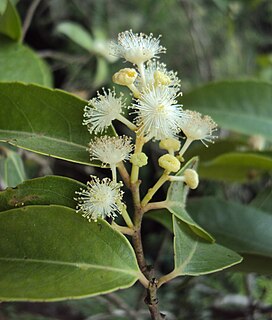
Scolopia crenata, known commonly as potato plum of Mysore, is a subcanopy tree found in tropical evergreen to semi-evergreen forests of Indo-Malaysia and the Western Ghats, up to 1800 m.
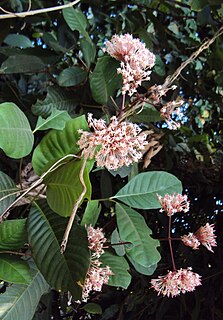
Ixora elongata, the rosy ixora, is a small tree endemic to the Western Ghats of India. They are found as undergrowth in evergreen to dry evergreen and semi-evergreen forests between 300 and 900 m.
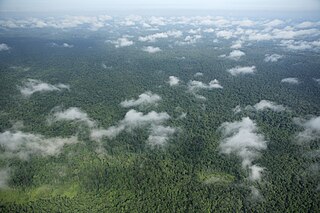
The Prey Lang Forest, also known as the Prey Long Forest, is a nature reserve forest in Kampong Thom, Preah Vihear, Kratie and Stung Treng Provinces in Northern Cambodia. The forest covers an estimated 3,600 square kilometres. It is one of Southeast Asia’s last remaining lowland evergreen woodlands. It is the largest remaining lowland evergreen forest on the Indochinese peninsula and approximately 200,000 members of ethnic minorities live in or around the Prey Lang.

Rinorea bengalensis is a species of plant in the family Violaceae. They are seen as understorey trees in wet evergreen forests up to 800 meters in Indomalaysia, Australia and Pacific Islands and in the Western Ghats they can be seen at Coorg and Chikmagalur Regions.


















